The History of Hiroshima City
1) Prehistoric and Ancient Times
The majority of the current area of Hiroshima City was under the sea, with the seawater reaching farther inland along the lower reaches of the present-day Ota River, forming a bay.
However, relics from the Jomon period have been found in places such as Ushita, Yano, Itsukaichi, and Hijiyama, which was an island in Hiroshima bay, and ruins dating to the Yayoi period have been discovered in Nakayama and Kami-Fukawa.
Given the fact that artifacts (such as bronze swords in Omoji and bronze bells, swords and dagger axes in Fukuda) dating from the late Yayoi period have been found, it is assumed that ancient Hiroshima was part of an area where two cultural zones, Kinki to the east and Kita-Kyushu to the west, came into contact with each other.
Ruins and ancient burial mounds from the Kofun period have been discovered distributed mainly around Asakita-ku and Asaminami-ku with the most well-known being the Nakaoda Kofun (ancient tomb) in Kuchita, and Unagiyama Kofun and Jinguyama Kofun in Midorii.
Under the Ritsuryo system, regional governance was mostly the responsibility of the provincial administrative agency.
In Aki Province, the ancient name of Hiroshima Prefecture, the provincial government offices were thought to be located in the Saijo basin or Fuchu-cho in Aki-gun. It has been confirmed that in the middle of the Heian period, administrative offices existed in Fuchu-cho, and Mita-go of Shiraki-cho and other towns were related to the provincial administrative agency.
As the Ritsuryo system gradually declined in power, royalty and aristocracy as well as temples and shrines came to possess manor estates, and in the late eighth century Hiroshima saw the establishment of Ushita Manor of the Saidaiji fiefdom as well as the Kabe Manor (in Kabe), Miiri Manor (in Miiri) and Tato Manor (near Kuchita).
In the area near Yamamoto in the Gion district (in those days near the mouth of the Ota River) there was land used for storing goods that were transported from the inland manor estate of the Itsukushima Shrine.
2) The Middle Ages
After the Jokyu War (1221), the Takeda clan, the newly appointed shugo (governor) of Aki Province, situated their government at Kanayama Castle.
A market soon developed around the castle environs, and as it became an increasingly active place, it also drew political activity away from the former center of Fuchu to the Kanayama Castle area. During the Namboku-cho period, the Takeda clan, at the invitation of the shogun Takauji Ashikaga, became allied with the Mori, Kikkawa, Kumagai and other clans, and had violent disputes in the power struggle against those opposing the shogunate at Yano Castle and other locales.
During the Muromachi period, the Takeda clan was removed from power as the provincial shugo, but at the beginning of the 15th century it was reinstated to govern over the Ota River area.
During this same time period, earth and sand carried down the Ota River began to accumulate, creating levees and embankments in the area of present-day Hiroshima City, and gradually formed a delta.
An area called Gokaura, adjacent to the Itsukushima Shrine's Ama Manor (near Yano), appears in a document dating to 1397 that includes mention of the delta shape, already visible at that time.
The Takeda clan fell into ruin in 1541, and in their place the stature of the Mori clan continued to grow in prominence. Later, the Mori clan’s defeat of the Sue clan during the Battle of Itsukushima in 1555 led to an even more rapid growth in stature for the clan.
When Hideyoshi Toyotomi took control of the country, a member of the Mori clan came to be daimyo (feudal lord) under his administration, possessing most of the Chugoku district and earning 1.12 million goku (the daimyo's income in units of rice).
The main center for administration of their vast territories was located at the home base of the Mori clan in Yoshida-Koriyama Castle in Takata-gun, Aki Province, but it later became necessary to move the clan base to a location that was better situated in regards to land and marine transportation from military, political and economic perspectives.
3) The Recent Past
In 1589, Terumoto Mori began construction of a castle on a delta at what was then called Goka (or Gokason, “Five Villages”) and the area was given the name of Hiroshima (“Wide Island”). At the same time, vassals from all regions in the territories migrated to the new Hiroshima, and workers and shopkeepers were invited as construction of a castle town, mimicking that of Kyoto and Osaka, was carried out.
In 1591, the castle was tentatively completed, Terumoto took up residence, and the surrounding field, once thick with reeds, was transformed into a castle town almost instantly.
In 1600, after the death of Hideyoshi Toyotomi, Terumoto Mori was defeated in the Battle of Sekigahara and as a result Terumoto was reduced to ruling only over the two provinces of Suo and Nagato. In his stead, Masanori Fukushima became daimyo of Aki and Bingo (eastern Hiroshima) provinces, collectively known as Geibi, earning 498,000 goku. The Fukushima clan expanded and improved upon the castle town they inherited from the Mori clan while also moving the Saikoku road (Sanyo highway) so that it would pass in front of the castle, and planning construction of the Unseki road leading to Izumo and Iwami provinces.
However, the Fukushima clan was penalized by the shogun for making unauthorized repairs to Hiroshima Castle by being transferred and having their territories confiscated. In 1619, Nagaakira Asano came from Wakayama to occupy Hiroshima Castle while also being granted control of all of Aki Province and eight counties of Bingo with their 426,000 goku.
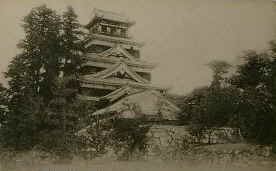
Hiroshima Castle before the dropping of the atomic bomb
Land reclamation works in the tidelands to the south of Hiroshima Castle during the Edo period allowed for rapid construction in that area with more than 35 new towns and villages established during the Bunsei period (around 1820). The population of these newly established settlements exceeded 48,000. Together with the original city dwellers of an estimated 20,000 samurai and persons residing in temples and shrines, the total population of the Hiroshima Castle town was near 70,000, following after Edo, Osaka, Kyoto, Nagoya and Kanazawa in terms of size.
Since Hiroshima was the largest city located on the inland sea shipping route, Hon and Motoyasu rivers were bustling with ships from other provinces around Japan, and the city enjoyed lively commerce. Numerous local products from surrounding areas (such as cotton grown in the coastal regions; hemp jute, paper, bamboo wares and vegetables from the Ota River basin; and seaweed, oysters and other marine products from Hiroshima Bay) were all brought into the area near Hiroshima Castle where they were consolidated and shipped off to Kyoto and Osaka.
The succession of rulers of the Asano domain is as follows: Nagaakira Asano, Mitsuakira, Tsunaakira, Tsunanaga, Yoshinaga, Munetsune, Shigeakira, Narikata, Naritaka, Yoshiteru, Nagamichi and Nagakoto.
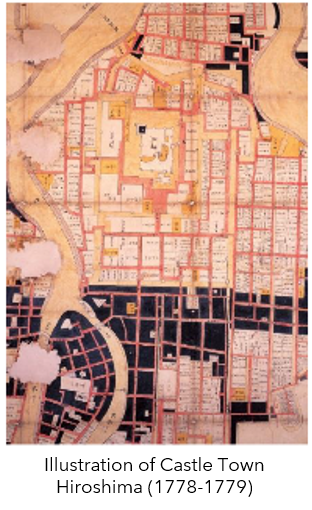
4) The Meiji and Taisho Periods
In July 1871, the abolition of feudal domains and establishment of prefectures was carried out, and in April of the following year (1872), the area near Hiroshima Castle became the first major district of Hiroshima Prefecture. In November 1878, the law establishing a system of counties, wards, towns and villages was enacted with the area being called the Hiroshima District.
A new system of municipalities was established in April 1888 and Hiroshima officially became one of the first cities in all of Japan in April 1, 1889. At that time Hiroshima covered a surface area of 27 km 2 with 23,824 households and a population of 83,387.
With the enactment of the system of municipalities, a great number of small villages on the periphery of Hiroshima were merged to form new municipalities. These municipalities were combined together during 1929, 1955 and 1956, and then successively merged into Hiroshima City from 1971 onwards.
Construction of the Ujina Port was started in September 1884 thanks to the efforts of then prefectural governor Sadaaki Senda, and was completed in November 1889. With this construction work, the sea from the Minami-Shinkai southward to Ujina Island was reclaimed to create a vast area of land. In June 1894, the Sanyo railroad line was extended to Hiroshima City.
The outbreak of the First Sino-Japanese War (1894) brought improvements to land and sea transportation facilities in Hiroshima City, such as the rapid two-week completion in August of that same year of the Hiroshima-Ujina railroad line for military use, since these facilities were strategic points within Japan and such activity further increased the economic prosperity of the city.
In September of that same year, Emperor Meiji moved the Imperial Headquarters to the Hiroshima Castle. Hiroshima looked like the temporary national capital as an extraordinary session of the Imperial Diet was held in October along with other official functions.
Connection to the Kure Naval Port was increased with the opening of the Kure Railroad Line in 1903 and the port became a principal military base with the outbreak of the Russo-Japanese war in 1904. From that time onward, Hiroshima City increasingly took on the aspect of a military city as numerous military facilities were constructed while at the same time the city became the political, economic, educational, cultural and transportation center of the whole Chugoku district.
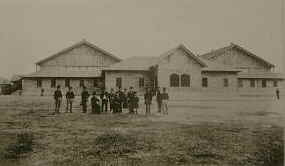
Extraordinary session of the Imperial Diet held in a provisional Diet building in Hiroshima City (1894)
As military facilities were reinforced, the construction of urban facilities progressed forward. Among these improvements was the filling in of the moat around Hiroshima Castle and the laying of track for an electric train atop part of this area. These changes dramatically altered the urban landscape.
In November 1912, the Hiroshima Electric Railway Co., Ltd., operators of trains within the city, opened four streetcar lines including a Hiroshima Station-Kamiya-cho-Aioi-bashi Bridge line. These lines replaced the former horse-drawn carriages and became the main form of transportation within the city.
The opening of the a streetcar line between Miyuki-bashi Bridge and Ujina in April 1915, and Sakan-cho and Yokogawa in November 1917 further increased convenient transportation in the city, consequently making the area around Hatchobori in the center of the city an economic hub just as important as the Nakajima-hon-machi and Sakai-machi areas had been since the castle town era. Eventually, the Hatchobori area surpassed these older areas to become the main business and shopping district of the city.
The only expansion of Hiroshima City through the Meiji and Taisho periods was the merging of Ujina-shima in Nihojima-mura (new name: Motoujina-machi) in September 1904.
5) The Showa, Heisei, and Reiwa Periods
The enactment of the City Planning Law in April 1919 saw the City of Hiroshima making provisions to conform to the new measures. In January 1925, it was decided that Hiroshima City and the seven municipalities (Niho-mura, Yaga-mura, Ushita-mura, Misasa-machi, Koi-machi, Furuta-mura and Kusatsu-machi) surrounding it at the time would constitute an urban planning area, and discussions regarding the merging of these seven municipalities were actively advanced. For this expansion, the first urban planning project of Hiroshima City was put into effect and the seven municipalities were merged in April 1929, increasing the population to over 270,000 and making it the seventh largest city in Japan.
In 1932, repair work for the Ota River was carried out while that same year the Ujina Port was renamed Hiroshima Port, with renovation work for the port beginning in 1933. From around 1935, against a backdrop of industrial modernization, more and more persons expressed the need for the construction of industrial port facilities, and in 1940 work began on industrial port facilities and construction of a coastal industrial zone on reclaimed land. At the same time, the military activity from the Manchurian Incident in September 1931 to the end of World War II in 1945 saw the construction of new military facilities and the expansion of existing ones together with barracks in Ujina for soldiers from all over Japan who would soon be dispatched from the port to overseas destinations.
On August 6, 1945, a single atomic bomb was detonated approximately 600 meters above the center of Hiroshima City, resulting in a blast that instantaneously reduced a thriving city, which at one time had a population of some 420,000 people to scorched earth with some reporting that Hiroshima would be barren and uninhabitable for the next 70 or 75 years.
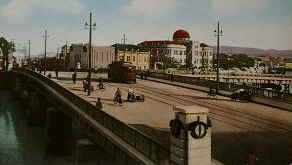
Aioi-bashi Bridge and Hiroshima Prefectural Industrial Promotion Hall before the dropping of the atomic bomb
The nearly instantaneous destructive power of the atomic bomb left the city in ruins, and recovery efforts were made difficult due to a lack of available funds and other factors. However, the first special law in Japan, the Hiroshima Peace Memorial City Construction Law, was enacted on August 6, 1949, ushering in an expansion of the city on the eve of Japan’s rapid economic expansion.
With the enactment of the Law to Promote Municipal Mergers in 1953 and the Law to Promote the Establishment of New Municipalities in 1956 created momentum for the merging of municipalities all across Japan. As a result of this trend, various villages were merged into Hiroshima City including Hesaka-mura, Aki-gun in April 1955, Nakayama-mura, Aki-gun in April 1956, and Inokuchi-mura, Saeki-gun in November of that same year, resulting in a population of 400,000 by 1957. By 1958 the population had exceeded the maximum reached before the war and reached 500,000 by April 1964.
Hiroshima City began to look like a major metropolis due to the opportunities that arose to expand the city’s facilities and services including the opening of the Hiroshima Airport (now Hiroshima Nishi Airport) in 1961, the opening of the completely electric Sanyo Honsen railroad line in 1964, the construction of flood control channels for the Ota River and the completion of Hiroshima Station, built with government and popular support in 1965, and the opening of the Shin-Hiroshima Bypass on National Highway Route 2 in 1966.
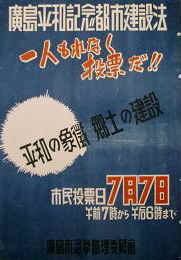
A poster for the referendum regarding the Hiroshima Peace Memorial City Construction Law (1949)
As a result, the various problems related to daily life issues expanded beyond the area of the city, increasing the momentum for the merging of outlying municipalities as an integrated solution to such problems. Other measures were worked out through a greater Hiroshima plan conceived in 1958, and soon followed by the initiative to construct a wide-scale metropolitan area with Hiroshima City at the core.
In January 1968, the Hiroshima Region Broader-Based Local Government Council was established consisting of Hiroshima City and 19 nearby municipalities, and in March 1970 the merging of these surrounding municipalities was promulgated in a single move with the formulation of the Hiroshima City Basic Plan.
In April 1971, Numata-cho, Asa-gun was merged followed by Asa-cho, Asa-gun in May of the same year, Kabe-cho, Asa-gun in April 1972, and Gion-cho, Asa-gun in August of the same year. In March 1973, Yasu-Furuichi-cho, Sato-cho, and Koyo-cho (all of Asa-gun) and Senogawa-cho, Aki-gun were merged, followed by Shiraki-cho, Takata-gun in October of the same year. Finally, Kumanoato-mura and Aki-cho (both of Aki-gun) were merged in November 1974, followed by Yano-cho and Funakoshi-cho (both of Aki-gun) were merged in March 1975, for a total of 13 municipalities merged with Hiroshima City.
On April 1, 1980, Hiroshima became the tenth Ordinance-Designated City in the country. With this designation, administration work and jurisdiction previously held by the prefecture was transferred to the city, streamlining municipal government and enabling the city access of new sources of funding that could be used for improvements in services for citizens, such as the promotion of construction for various city facilities. With the introduction of municipal wards, the City was also able to strengthen the ties between citizens and the municipal government. In March 1985, Itsukaichi-cho in Saeki-gun joined Hiroshima City, pushing the population to over one million. In April 2005, Yuki-cho in Saeki-gun also joined the city, putting our current population at over 1.18 million.
After becoming an Ordinance-Designated City, sports centers, libraries, and cultural centers were gradually established in populous regions of each ward for its citizens. In addition, the Hiroshima City Museum of History and Traditional Crafts, Hiroshima City Museum of Contemporary Art, Aster Plaza, Edion Stadium Hiroshima (Big Arch), and the International Conference Center were also built, further enhancing a broad range of cultural and sports facilities as a central city in the Chugoku/Shikoku region. In 1994, the Asian Games were held primarily at one such facility, Kōiki Park, which is home to international competition-level sports facilities. It was the first time that the Asian Games were held in a regional city. In April of the same year, Hiroshima City University opened in the hilly region that faced the park, accelerating the development of the surrounding region.
In 1982, construction of a large-scale commercial district and residential district began at the same time as development projects for the western part of Hiroshima City. Before and after the Asian Games, the development of a new city center continued with the development of the Seifū Shinto area, as well as the grand opening of Shareo, an underground shopping area in Kamiya-cho, in 2001.
The economy of the city grew steadily with development of social capital, such as the opening of the Sanyō Shinkansen Line in 1975 and jet planes flying in and out of Hiroshima Airport (currently Hiroshima Heliport) in 1979. In 1994, the Astram Line, a new public transport system, was introduced along with the new Gion Road to alleviate chronic traffic from the northern part of the city. In 2015, Shin-Hakushima Station was opened at the crossroads of the JR Sanyō Honsen Line, further strengthening our public transportation network. Additionally, in 2001, Route 4 of the Hiroshima Expressway (the Hiroshima-Seifū Shinto Line) was opened, with Routes 1, 2, and 3 opening soon after, ringing in a new era of city expressways.
The area around Hiroshima Station is the eastern pillar of the city center. In 1981, the First City Re-Development Plan for the A Block of the Hiroshima Station South Exit was drafted, and in 1999, the plan was completed. With the completion of Mazda Stadium, a new baseball stadium, in March 2009, development accelerated rapidly, and in 2017, development of the nearby B and C Blocks were completed, bringing new vitality to the area. In addition, the redevelopment of the Hiroshima Station South Exit plaza, including the construction of an Eki-mae Ohashi Bridge streetcar route, is underway and making significant progress. As for the western pillar of the city center, the Kamiya-cho and Hatchobori areas, they were designated as Specified Areas for Urban Renewal via Immediate Development. This designation has facilitated building reconstruction and redevelopment by private companies, as well as the construction of a new landmark symbol soccer stadium for Hiroshima.
As the city continues to grow and buildings that survived the atomic bombing (hibaku buildings) are torn down, the Atomic Bomb Dome, an important witness to the atomic bombing, was registered as a World Heritage Site in 1996. In 2002, the Hiroshima National Peace Memorial Hall was established, and, together with the Hiroshima Peace Memorial Museum, it continues to convey the horrors of the atomic bombing and the importance of peace through exhibits of items left behind by the hibakusha, as well as survivor testimonies and more.
Hiroshima continues to appeal for the abolition of nuclear weapons and the realization of lasting world peace, garnering a high level of interest from both inside and outside of Japan. We have hosted many high-profile guests from around the world, including a visit in May 2016 by US President Barack Obama and a visit in 2019 by the Pope Francis. In particular, the visit by President Obama was the first visit by a sitting US president and was a historic step toward the abolition of nuclear weapons.
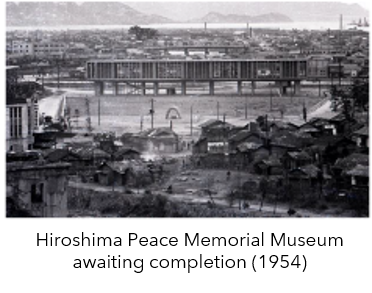
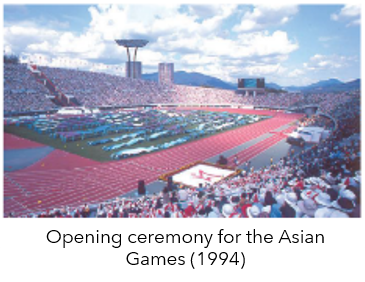
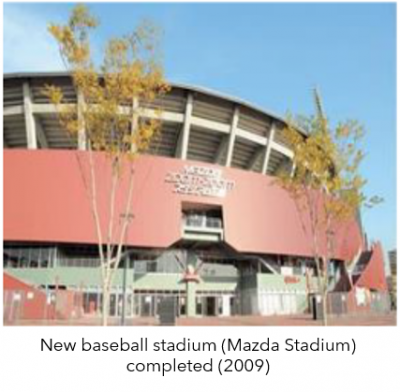
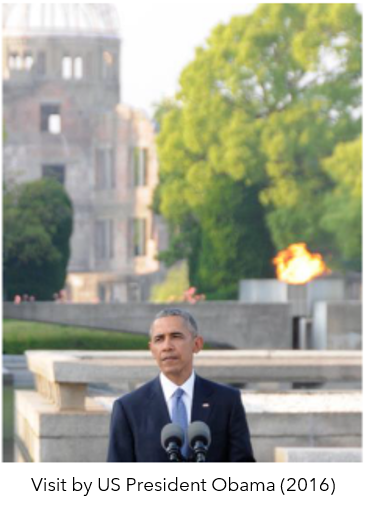
Inquiries about this page
Statistical Analysis Section, Policy Planning Division
Planning and Coordination Department, Planning and General Affairs Bureau
1-6-34 Kokutaiji-machi, Naka-ku, Hiroshima City, Japan 730-8586
Tel: 082-504-2012 / Fax: 082-504-2029
Mail: [email protected]
